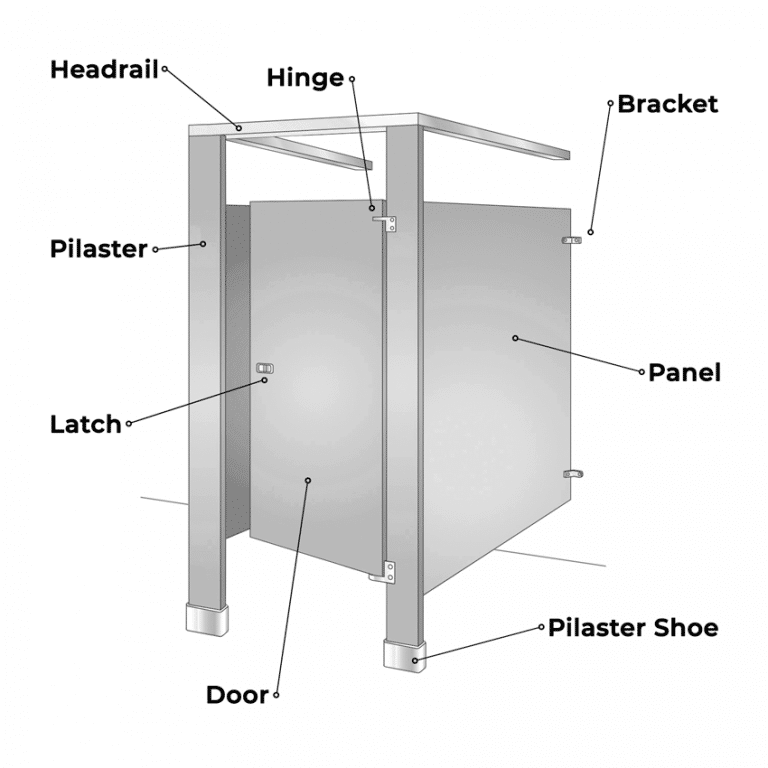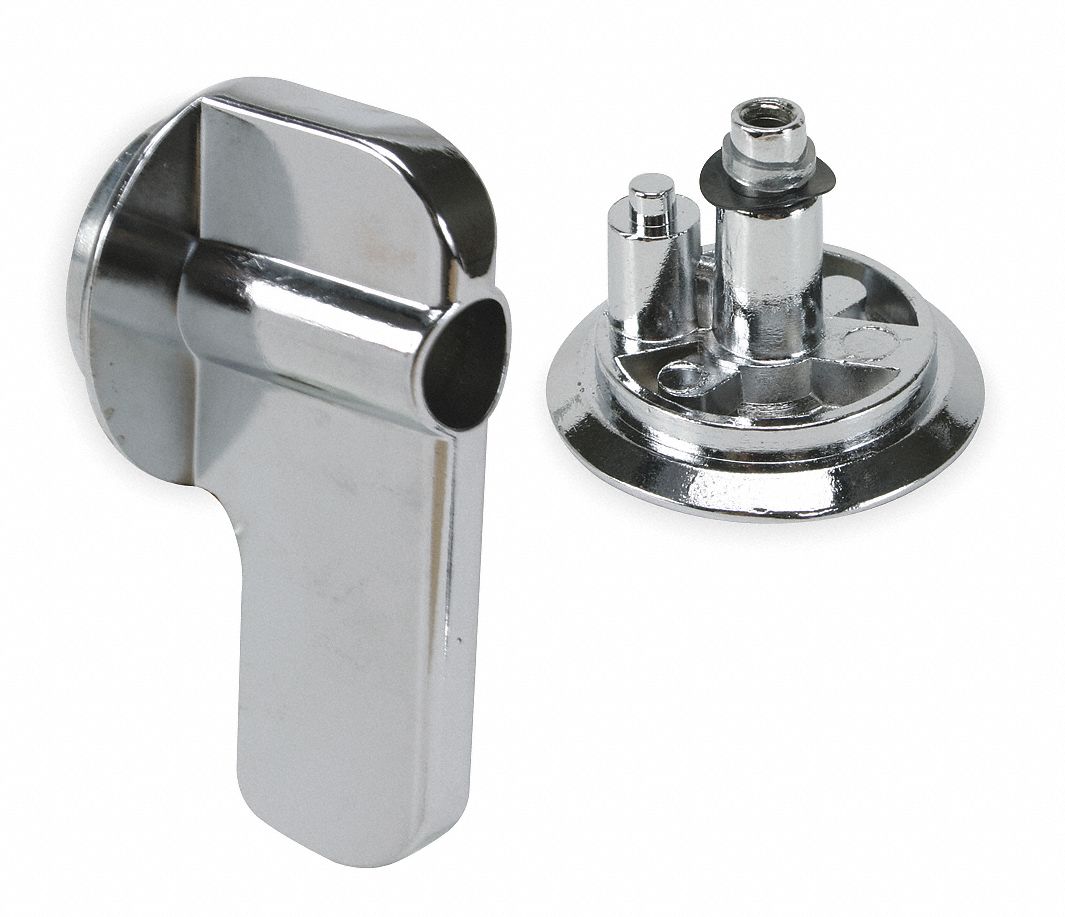Types of Bathroom Stall Door Locks
Bathroom stall door locks are essential for providing privacy and security in public restrooms. They come in various types, each with its unique mechanism, features, and applications. Choosing the right type of lock depends on factors such as budget, security requirements, and the specific needs of the facility.
Push-Button Locks
Push-button locks are the most common type of bathroom stall door lock. They are simple to use and relatively inexpensive. These locks typically consist of a latch that is released by pressing a button on the outside of the door.
- Mechanism: Push-button locks utilize a spring-loaded latch that is engaged when the door is closed. Pressing the button on the outside of the door releases the latch, allowing the door to open.
- Features: Push-button locks are typically made of durable materials like metal or plastic. They are available in various finishes to match the décor of the restroom.
- Advantages: Push-button locks are easy to use, inexpensive, and readily available.
- Disadvantages: Push-button locks are relatively easy to force open, and they may not be suitable for high-security applications.
Privacy Locks
Privacy locks provide a higher level of security than push-button locks. They are commonly found in restrooms that require a greater degree of privacy, such as hotel rooms or healthcare facilities.
- Mechanism: Privacy locks use a locking mechanism that requires a key or a lever to release the latch. This makes them more difficult to force open than push-button locks.
- Features: Privacy locks are typically made of durable metal and are available in various finishes. They may also include features such as a deadbolt for additional security.
- Advantages: Privacy locks offer a higher level of security than push-button locks, making them suitable for applications where privacy is essential.
- Disadvantages: Privacy locks are more expensive than push-button locks, and they may require more time to install.
Keyed Locks
Keyed locks are the most secure type of bathroom stall door lock. They are often used in high-security areas such as prisons or hospitals.
- Mechanism: Keyed locks use a locking mechanism that requires a specific key to release the latch. These locks are highly resistant to forced entry.
- Features: Keyed locks are typically made of durable metal and are available in various finishes. They may also include features such as a deadbolt or a key cylinder cover for added security.
- Advantages: Keyed locks provide the highest level of security among all types of bathroom stall door locks. They are difficult to force open and are suitable for high-security applications.
- Disadvantages: Keyed locks are the most expensive type of bathroom stall door lock. They also require a key to be used, which can be inconvenient in some situations.
Comparison of Bathroom Stall Door Lock Types
| Lock Type | Materials | Installation Method | Common Uses |
|---|---|---|---|
| Push-Button | Metal, Plastic | Surface Mount | Public restrooms, Schools, Offices |
| Privacy | Metal | Surface Mount | Hotels, Hospitals, Healthcare facilities |
| Keyed | Metal | Surface Mount | Prisons, Hospitals, High-security areas |
Essential Bathroom Stall Door Lock Parts

Bathroom stall door locks are crucial for privacy and security in public restrooms. These locks consist of several essential parts that work together to ensure a secure and reliable locking mechanism. Understanding the different components and their functions is essential for choosing the right lock for your needs and for maintaining its proper operation.
Materials Used for Bathroom Stall Door Lock Parts
The materials used for bathroom stall door lock parts play a significant role in their durability, aesthetics, and resistance to corrosion. Here’s a breakdown of common materials and their characteristics:
- Stainless Steel: A highly durable and corrosion-resistant material often used for lock parts that experience frequent use and exposure to moisture. It provides excellent strength and a sleek, modern appearance.
- Brass: Known for its durability and resistance to corrosion, brass is a popular choice for lock parts. It offers a classic and elegant look and can be polished to a high shine.
- Zinc Alloy: A cost-effective material that provides good durability and resistance to corrosion. Zinc alloy is often used for lock parts that require a balance of strength and affordability.
- Plastic: Some lock parts, such as the latch or handle, may be made from durable plastic. This material is lightweight and offers good resistance to corrosion, but it may not be as strong as metal.
Components of a Bathroom Stall Door Lock, Bathroom stall door lock parts
A typical bathroom stall door lock comprises several key components that work together to provide a secure locking mechanism:
- Latch: The latch is the part of the lock that engages with the strike plate to secure the door. It typically features a spring-loaded mechanism that retracts when the handle is turned, allowing the door to open.
- Handle: The handle is the part of the lock that users interact with to lock and unlock the door. It can be designed in various styles, including lever handles, knob handles, and push-button handles.
- Strike Plate: The strike plate is a metal plate attached to the door frame that the latch engages with. It provides a solid surface for the latch to secure the door and prevents damage to the door frame.
- Mounting Hardware: This includes screws, bolts, and other fasteners that are used to attach the lock to the door and the strike plate to the door frame. The mounting hardware should be made of durable materials that can withstand the weight and stress of the door.
Function of Each Component
Each component of a bathroom stall door lock plays a crucial role in securing the door:
- Latch: The latch is the core of the locking mechanism. It engages with the strike plate when the handle is turned, preventing the door from opening.
- Handle: The handle provides the user interface for the lock. Turning or pushing the handle activates the latch, locking or unlocking the door.
- Strike Plate: The strike plate provides a solid surface for the latch to engage with, ensuring a secure and reliable locking mechanism.
- Mounting Hardware: The mounting hardware holds the lock in place and securely attaches the strike plate to the door frame, ensuring that the lock functions properly and remains securely installed.
Troubleshooting and Repairing Bathroom Stall Door Lock Parts

Bathroom stall door locks, though seemingly simple, can encounter various issues over time. From a malfunctioning latch to a broken handle or a loose strike plate, these problems can disrupt privacy and convenience. Understanding common lock problems and knowing how to troubleshoot and repair them can save you time and money.
Troubleshooting Common Bathroom Stall Door Lock Issues
Identifying the root cause of a lock problem is crucial for effective repair. Here’s a breakdown of common issues and their corresponding troubleshooting steps:
- Malfunctioning Latch: The latch is the mechanism that secures the door. If the latch doesn’t engage properly, the door won’t lock.
- Troubleshooting: Check if the latch is obstructed by debris or dirt. Clean the latch mechanism and ensure it moves freely. If the latch is bent or damaged, it may need replacement.
- Broken Handle: A broken handle can prevent you from opening or closing the door.
- Troubleshooting: Inspect the handle for cracks or loose screws. Tighten loose screws or replace the handle if it’s broken.
- Loose Strike Plate: The strike plate is the metal plate on the door frame that the latch engages with. A loose strike plate can cause the door to not latch properly.
- Troubleshooting: Check if the strike plate screws are loose. Tighten the screws or replace the strike plate if it’s damaged.
- Jammed Lock: A jammed lock can prevent you from opening or closing the door.
- Troubleshooting: Try lubricating the lock mechanism with a light oil. If the lock is still jammed, you may need to disassemble it and clean it thoroughly. If the lock is severely damaged, it may need replacement.
Repairing Bathroom Stall Door Lock Parts
Once you’ve identified the problem, you can proceed with the repair. Here’s a step-by-step guide for repairing common lock problems:
- Replacing a Malfunctioning Latch:
- Step 1: Remove the door handle. This usually involves unscrewing the handle from the door.
- Step 2: Remove the old latch. The latch is typically held in place by screws. Remove the screws and pull the latch out.
- Step 3: Install the new latch. Align the new latch with the holes in the door and insert the screws. Tighten the screws securely.
- Step 4: Reinstall the door handle. Make sure the handle is securely attached.
- Replacing a Broken Handle:
- Step 1: Remove the old handle. This usually involves unscrewing the handle from the door.
- Step 2: Install the new handle. Align the new handle with the holes in the door and insert the screws. Tighten the screws securely.
- Replacing a Loose Strike Plate:
- Step 1: Remove the old strike plate. This usually involves unscrewing the strike plate from the door frame.
- Step 2: Install the new strike plate. Align the new strike plate with the holes in the door frame and insert the screws. Tighten the screws securely.
- Lubricating a Jammed Lock:
- Step 1: Apply a light oil to the lock mechanism. You can use a lubricant like WD-40 or a dry graphite lubricant.
- Step 2: Work the lock back and forth several times to distribute the lubricant.
Table of Potential Issues and Troubleshooting Steps
Here’s a table summarizing potential issues and their corresponding troubleshooting steps:
| Issue | Troubleshooting Steps |
|---|---|
| Malfunctioning Latch | – Check for obstructions and clean the latch mechanism. – Replace the latch if it’s bent or damaged. |
| Broken Handle | – Tighten loose screws. – Replace the handle if it’s broken. |
| Loose Strike Plate | – Tighten the strike plate screws. – Replace the strike plate if it’s damaged. |
| Jammed Lock | – Lubricate the lock mechanism with light oil. – Disassemble and clean the lock if necessary. – Replace the lock if it’s severely damaged. |
Bathroom stall door lock parts – Right, so you’re trying to fix a bathroom stall door lock, yeah? Those things are always going on the fritz. Maybe you’re thinking about upgrading to a more solid, cement door for bathroom , but for now, you’re stuck with that flimsy wooden one.
Anyway, good luck with those lock parts, mate. You’ll need it.
Right, so you’re tryna fix those dodgy bathroom stall door locks, yeah? Well, if you’re going for a more chilled vibe, maybe chuck in a harbor blue bathroom vanity to match. But if you’re all about that classic look, then stick with the original parts, innit?
